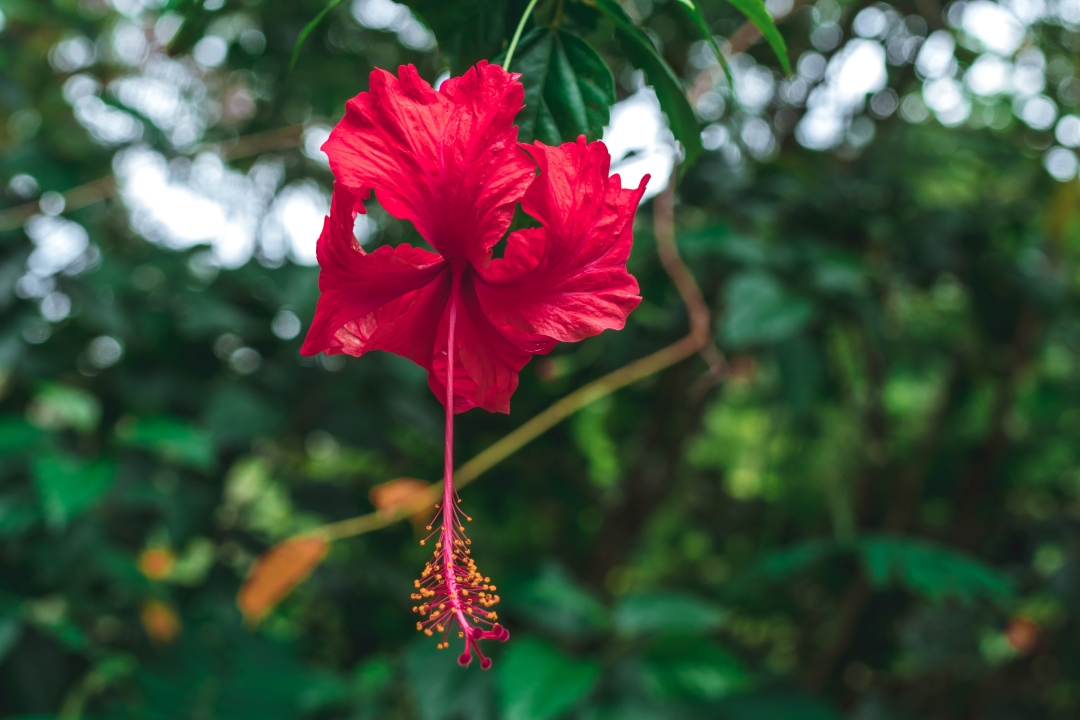
The typical Malaysian hibiscus is a species of a flowering plant in the Hibisceae tribe of the family Malvaceae.
ROSELLE is a close relative of our national flower, ‘Bunga Raya’ (Hibiscus rosa-sinensis), which is colloquially known as the Chinese hibiscus, the China rose, or the Hawaiian hibiscus.
Our hibiscus is a species of a flowering plant in the Hibisceae tribe of the family Malvaceae.
We are familiar with the few hibiscus varieties, but not all of us know the economic importance of this plant and its related species.
The Hibiscus rosa-sinensis is a bushy, evergreen shrub that may grow up to 15 feet tall. The name translates almost perfectly to the Greek word ‘hibiskos’, which means ‘mallow’.
The specific epithet, ‘rosa-sinensis’, literally means ‘Rose of China’.
Recently, I did some severe pruning, cutting the plant down to two feet to the basal stem for regeneration. The red five-petal flowers may have yellow, dark red and white cultivars.
There are some with extra-large petals with a single tier, and there are others that may come with double flowers.
The stigma is located amongst the hairy red spots on the top of the pistil. The anthers that release the pollen make up the stamen, the male reproductive part of a flower, which is attractive to the nectarivore hummingbirds and the butterfly, Papilio homerus.
The genetic characteristic is known as ‘polyploidy’ – meaning there are two sets of chromosomes, a condition where the ‘phenotype’ (observable physical properties of an organism) of the offspring may be different from the parents’. This condition leads to crossing and re-crossing that produce new varieties, resulting in the plant bearing strikingly unique flowers. In this regard, the hobbyists are known to offer new flowers for competitions.

The blooms of the Hibiscus rosa-sinensis can come with multiple petals.
The roselle (Hibiscus sabdariffa) is a species of flowering plant from the genus Hibiscus naturally occurring in West Africa. It is a prized primarily for the cooling, lemonade-like beverage made from the calyces. The beverage tastes somewhat like ‘Ribena’. It is said it possess anti-hypertensive, diuretic and mild laxative properties.
The drink contains abundant natural antioxidants, Vitamin C and anthocyanins.
The Jamaican sorrel or java jute is a tall red and green roselle shrub that makes for a colourful hedging and landscape work.
Cultivation
This shrub grows best in moist, well-drained loamy soil under the full sun. Stem-cuttings are used for propagation. Owing to the numerous cultivars that produce various colours and forms, hibiscus is common in landscaping and is still popular for pot-planting.
Some of them are the white cultivar called Hibiscus acetosella, and also the double-flower one called Hibiscus schizopetalus that has nicknames like Japanese hibiscus, ‘Japanese Lantern’, the ‘Shoeflower’ and ‘Coral Hibiscus’.
Growing can initiated via cuttings or seeds. Taking fresh cuttings off the stem and directly insert them into the soil beds would strike the roots for new plants. It is better if rooting hormone is used to speed up the process.
Both seeds and cuttings are viable to generate new plant on the ground; pot-planting is possible as the plant can grow up to about five feet tall.
The leaves are deeply lobed and arranged alternately along the stems. The flowers are three to four inches in diameter, with dark red spots at the base of the petals and each has a stout, conspicuous calyx.
Refreshing drink

The roselle plant is prized primarily for its calyces, the key ingredient in making the cooling, lemonade-like beverage. — Photo by Kien Nguyen
Roselle juice is easy to make at home. Use hands to peel the calyses and remove the seed capsules. Place the calyces in a large pot, fill in water and boil for 15 to 20 minutes – the longer we boil, the more concentrated the juice would be.
To avoid that overwhelming tart taste, add sugar to taste – alternatively, honey is also OK.
After boiling, let the crimson solution cool.
This drink is best served chilled – adding lots of ice makes it a very refreshing treat.
Twenty pieces of roselle calyces cook well in two litres of water; add in four tablespoon of sugar and it should sufficiently serve 10 people.
Happy Gardening!
